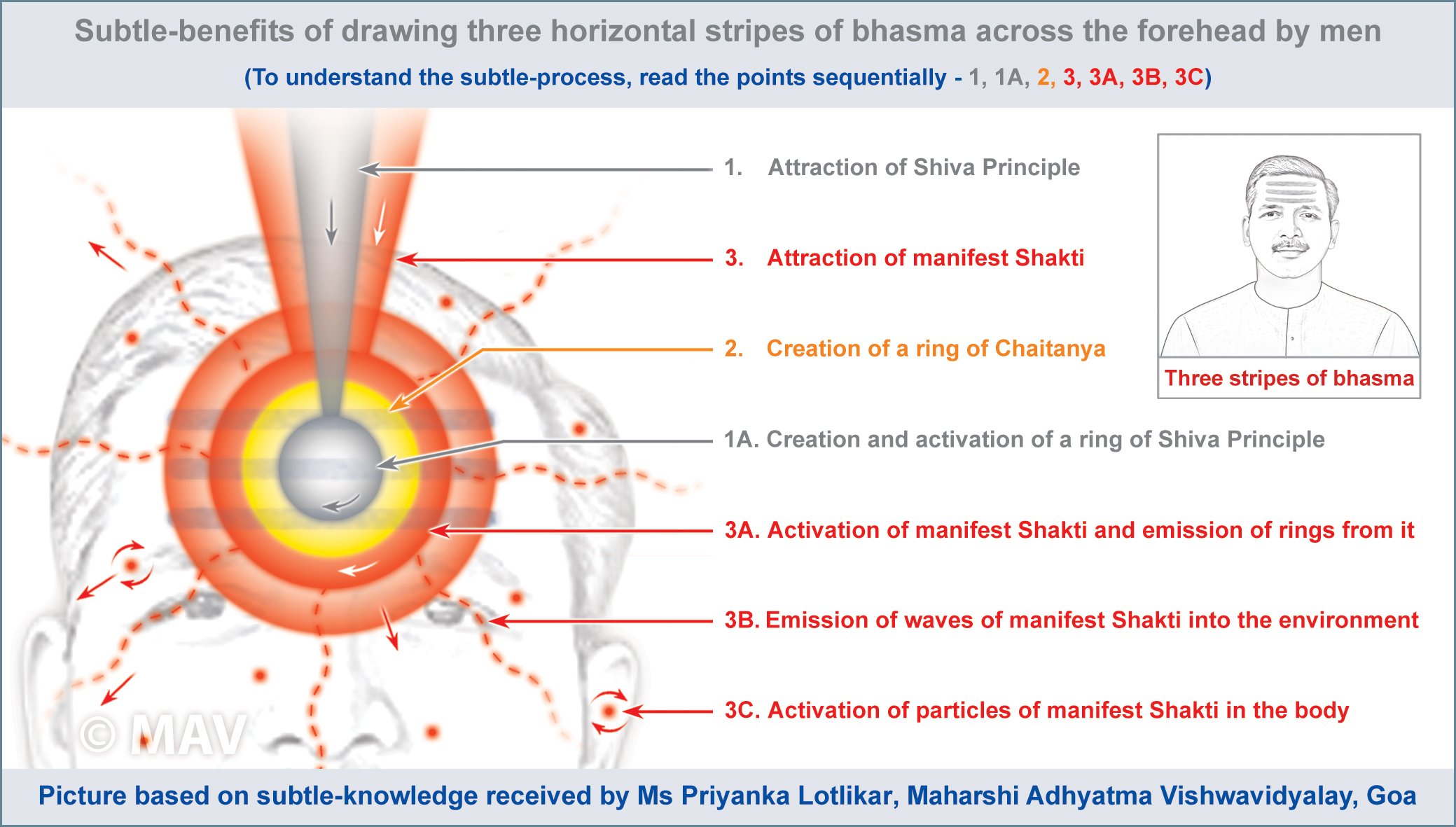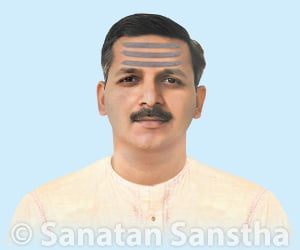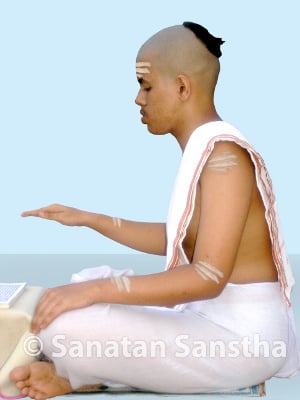Definition of bhasma
It is a misconception that ash that remains after burning some object is known as bhasma. Strictly speaking, the remains of samidha (Sacrificial firewood) and ghee (Clarified butter) after they are burnt in a Yadnya (Sacrificial fire) are known as bhasma. Some people bathe the Idol with ash as part of ritualistic worship. The ash that has turned Holy because of contact with the Deity’s Idol is then used as bhasma.
Meaning of bhasma and importance
‘Bha’ in the word bhasma means elimination and ‘sma’ means remembrance. It is because of bhasma, that demerits are eliminated and God is remembered.
Synonyms of Bhasma
Vibhuti, raksha and rakha.
Where should the bhasma be applied ?
1. Along with a mantra
Shri Gurucharitra, Chapter 29 says Bhasma should be placed on the palm while chanting mantras such as Sadyojat etc. It should be made sacred with mantras such as Agniriti etc. || 200 ||
Uttering mantras such as Manastoke etc. bhasma should be rubbed between the thumb and the forefinger. With mantras such as Tryambak, it should be applied to the forehead. || 201 ||
Chanting the Tryayusha mantra, it should be applied to the forehead and arms. Thus, amidst chanting of the same mantras, bhasma should be applied to different parts of the body. || 202 ||
2. With bhav (Spiritual emotion)
One who does not know mantras should apply it with pure bhav. Its effects will be tremendous. – Shri Gurucharitra, Chapter 29, Line 204
3. According to Rugvedic Brahmakarma
The ritual of applying bhasma is provided in Rugvedic Brahmakarma. Its synopsis is provided here. Perform achaman (Sipping water from the cupped palm thrice, while uttering the first three of the twenty-four names of Shrivishṇu and releasing the water into a plate from the palm while uttering the fourth name) and Pranayam (Regulation of breath and control of the body’s vital energies) and take some bhasma on the palm of the left hand. Recite the mantra ॐ मानस्तोके० (Om Manastoke) and soak it in water. Recite the mantra ॐ ईशानः| (Om Ishanaha) and apply it to the head, recite the mantra ॐ तत्पुरुषाय० (Om Tatpurushaya) and apply it to the face, recite the mantra ॐ अघोरेभ्यो० (Om Aghorebhyo) and apply it to the heart, recite the mantra ॐ वामदेवाय० (Om Vamadevaya) and apply it to the genitals and recite the mantra ॐ सद्योजात० (Om Sadhyojata) and apply it to the legs.
Tripundra
Tripundra means 3 horizontal stripes of bhasma.
1. Method of applying bhasma according to Brahmakarma section of the Rugveda
Touch the bhasma on the left palm with the right hand and charge it by reciting 7 mantras such as ॐ अग्नीरिति भस्म, वायुरिति भस्म (Om Agniriti bhasma, Vayuriti bhasma) etc. Then using the second, middle and ring fingers of the right hand, smear it horizontally across the forehead. After that, apply it to the face, heart, throat, navel, right and left arms, both sides of the abdomen, genitals and the legs. After applying it all over the body, the Name of Deity Shiva should be chanted thrice.
First the upper and lower stripes should be drawn from the left to the right using the middle and ring finger. Then, the middle stripe should be drawn from the right to the left using the thumb. (Since the stripes are drawn in both the directions, instead of the right or the left channel (Pingala and Ida nadis), it facilitates activation of the central channel (Sushumna-nadi.) – Shri Gurucharitra, Chapter 29, Line 204
The tripundra should be shaped like the eyebrows. Often a dot of bhasma is applied in the middle of these three stripes.
2. Implied meaning of the three stripes
1. Three eyes of Deity Shiva.
2. Tripundra means dnyan (Spiritual knowledge), bhakti (Devotion) and vairagya (Detachment).
3. According to Vasudevopanishad, tripundra represents the trinity, three vyahyati (The three mystic words uttered during the ritual of sandhya) and the three verses.
Subtle-benefits of drawing three horizontal stripes of bhasma across the forehead by men

1. Accuracy of the picture based on subtle-knowledge : 80%
2. Positive vibrations in the picture : 2%’ – H.H. Dr Jayant Athavale
3. Proportion of vibrations in the picture denoting subtle benefits : Shanti (Peace) (That is experienced) 0.75%, Shivatattva 2%, Chaitanya (Divine consciousness) 1% and manifest Shakti (Divine Energy) 2.75%
4. Other aspects
A. If a man draws 3 stripes of bhasma with the ring finger, middle finger and index finger, through it he partially obtains Apatattva, Tejtattva and Vayutattva.
B. The stripes of bhasma drawn on the forehead are associated with the lines of fate.
C. Special characteristics of stripes of bhasma that attract the Shivatattva : The shape of the tilak applied to the forehead is decided according to the Deity’s Principle. For example, the stripes of bhasma drawn on the forehead attract Shivatattva. Since Shiva is the Deity of Dissolution, straight lines attracting the Shivatattva are drawn on the forehead. A straight line denotes Shanti and stability. Similarly, the three stripes on the forehead are associated
with the three basic components and with Creation, Sustenance and Dissolution.
D. Special characteristics of the individual applying the bhasma : The vibrations generated by the tilak are activated in the body. The basic nature and the Path of Spirituality of an individual can be identified from the shape of the tilak. For example, the basic nature of individuals applying bhasma is calm externally & angry within. Since these individuals are worshippers of Shiva, they follow the Path of meditation and they have greater sense of detachment.
E. I perceived vibrations of Shanti in the bhasma.
– Ms Priyanka Lotlikar, Maharshi Adhyatma Vishwavidyalay, Goa.
Other uses of bhasma
1. It is said in the Holy scripture Jabalshruti that bhasma is useful in acquiring Brahmavidya (The Science of Brahman or the knowledge of the Absolute reality).
2. Vibhuti is a synonym for bhasma. The word Vibhuti is used in the context of mantra-tantra, or black magic for the purpose of self-protection or safeguarding the directions.
3. Vibhuti is applied to the forehead of the sick and children.
4. The bhasma generated from various substances such as iron, gold, pearl, diamond etc. is used as medicine in Ayurveda. It is highly effective.
5. Since the Vibhuti provides protection from distress due to the negative energies, it is blown at the place of distress (caused by negative energies) and applied to the individual suffering from such distress.
Ash is everlasting like Brahman
There are innumerable tangible and intangible objects in the Creation. Even if they are all destroyed, Brahman is eternal. Since Brahman is immortal, He can never be destroyed, nor does He gets destroyed. Similarly, ash too cannot be destroyed even if it is burnt.
What does bhasma teach us ?
1. If you sacrifice yourself and become bhasma, you will be sacrificing your (worldly) aims, personality defects, lack of knowledge and ego, and acquiring purity of the mind.
2. Since the human body has limited life, it is going to turn to ash after death. Hence, none should be desirous of the body. Bhasma signifies this. You should always be aware of the fact that death can come any moment. Hence, you should put to full use the human birth you have received after great effort. For this, you should make efforts to ensure that every moment is Holy and blissful.
3. Bhasma teaches us detachment.
Reference : Sanatan Sanstha’s Holy Text ‘Shiva’



